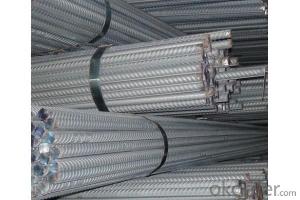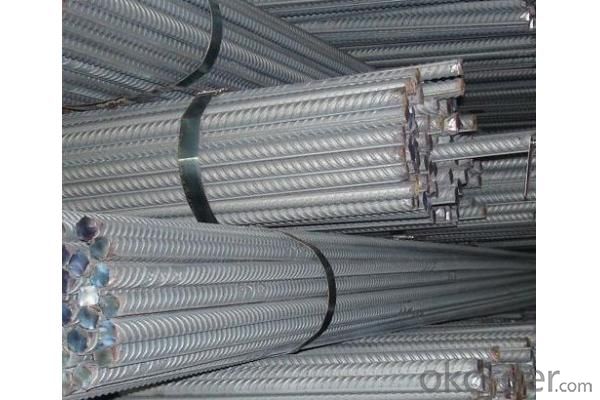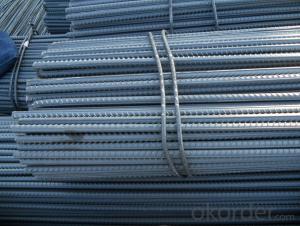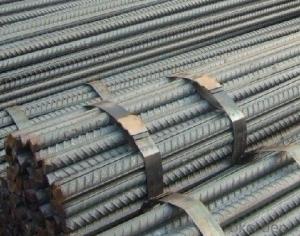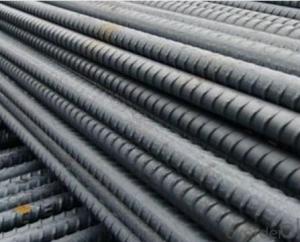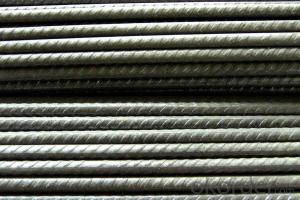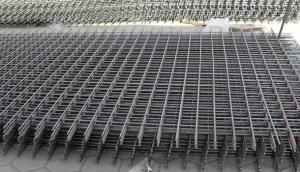High Quality Reinforcing Steel Rebars
- Loading Port:
- China Main Port
- Payment Terms:
- TT or LC
- Min Order Qty:
- -
- Supply Capability:
- -
OKorder Service Pledge
OKorder Financial Service
You Might Also Like
Product Description:
OKorder is offering High Quality Reinforcing Steel Rebars at great prices with worldwide shipping. Our supplier is a world-class manufacturer of steel, with our products utilized the world over. OKorder annually supplies products to African, South American and Asian markets. We provide quotations within 24 hours of receiving an inquiry and guarantee competitive prices.
Product Applications:
High Quality Reinforcing Steel Rebars are ideal for structural applications and are widely used in the construction of buildings and bridges, and the manufacturing, petrochemical, and transportation industries.
Product Advantages:
OKorder's High Quality Reinforcing Steel Rebars are durable, strong, and wide variety of sizes.
Main Product Features:
· Premium quality
· Prompt delivery & seaworthy packing (30 days after receiving deposit)
· Can be recycled and reused
· Mill test certification
· Professional Service
· Competitive pricing
Product Specifications:
Manufacture: Hot rolled
Grade: HRB335,HRB400,HRB500
Size: 6mm-32mm
Certificates: ISO, SGS, BV, CIQ
Length: 6m – 12m, as per customer request
Packaging: Export packing, nude packing, bundled
| DEFORMED BAR | |
| SIZE d(mm) | theoretical kg/m |
| 6 | 0.222 |
| 8 | 0.395 |
| 10 | 0.617 |
| 12 | 0.888 |
| 14 | 1.21 |
| 16 | 1.58 |
| 18 | 2 |
| 20 | 2.47 |
| 22 | 2.98 |
| 25 | 3.85 |
| 28 | 4.83 |
| 32 | 6.31 |
Grade | Technical data of the original chemical composition (%) | |||||||
C | Mn | Si | S | P | V | |||
HRB400 | ≤0.25 | ≤1.60 | ≤0.80 | ≤0.045 | ≤0.045 | 0.04-0.12 | ||
Physics capability | ||||||||
Yield Strength(N/cm2) | Tensile Strength(N/cm2) | Elongation (%) | ||||||
≥400 | ≥570 | ≥14 | ||||||
FAQ:
Q1: Why buy Materials & Equipment from OKorder.com?
A1: All products offered byOKorder.com are carefully selected from China's most reliable manufacturing enterprises. Through its ISO certifications, OKorder.com adheres to the highest standards and a commitment to supply chain safety and customer satisfaction.
Q2: How do we guarantee the quality of our products?
A2: We have established an advanced quality management system which conducts strict quality tests at every step, from raw materials to the final product. At the same time, we provide extensive follow-up service assurances as required.
Q3: How many tons of steel products could be loaded in containers?
A3: Usually the steel products are delivered by bulk vessel because of the large quantity and the freight. However, there are no bulk vessel enter some seaports so that we have to deliver the cargo by containers. The 6m steel product can be loaded in 20FT container, but the quantity is changed according to the size, usually from 18tons to 25tons.
Images:

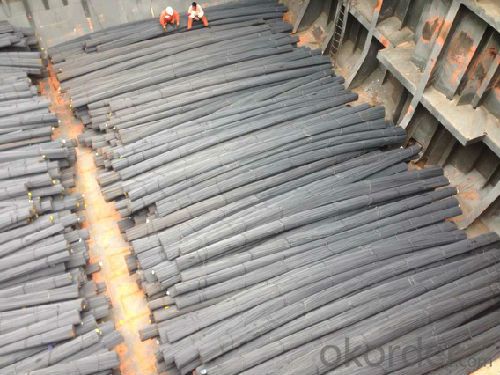
- Q: What are the guidelines for proper handling and disposal of steel rebars on construction sites?
- The guidelines for proper handling and disposal of steel rebars on construction sites are as follows: 1. Handling: - Wear appropriate personal protective equipment (PPE) such as gloves and safety glasses when handling steel rebars. - Lift and carry rebars properly using your legs and not your back to prevent injuries. - Do not throw or drop rebars as this can cause damage to the surrounding area and potentially harm workers. 2. Storage: - Store rebars in a designated area that is easily accessible and away from traffic or other hazards. - Stack rebars vertically to prevent them from rolling or falling. - Use racks or shelves to organize rebars and prevent them from getting tangled or damaged. 3. Disposal: - Rebars that are damaged or have reached the end of their usable life should be disposed of properly. - Contact local waste management authorities to determine the specific disposal requirements for steel rebars in your area. - If recycling is available, consider sending the rebars to a recycling facility to reduce waste and promote sustainability. - Do not dispose of steel rebars in regular trash bins or open areas, as they can pose a safety hazard. 4. Transportation: - When moving rebars within the construction site or transporting them to another location, secure them properly to prevent them from falling off the vehicle or causing damage. - Use appropriate vehicles such as trucks or trailers with sufficient tie-down points to ensure proper transportation. 5. Training and Communication: - Ensure that all workers involved in handling and disposal of steel rebars are properly trained on the guidelines and safety procedures. - Clearly communicate the guidelines to all workers, including subcontractors or temporary workers, to ensure consistent adherence to the rules. - Regularly review and update the guidelines as necessary to address any evolving safety concerns or regulatory changes. By following these guidelines, construction sites can promote a safe and organized working environment while ensuring proper handling and disposal of steel rebars.
- Q: How do steel rebars contribute to the seismic performance of a structure?
- Steel rebars contribute to the seismic performance of a structure by enhancing its strength and ductility. When embedded in concrete, rebars act as reinforcement, providing tensile strength to resist the forces generated during an earthquake. This reinforcement helps prevent cracking and failure in the concrete, allowing the structure to better absorb and dissipate seismic energy. Additionally, the flexibility and high yield strength of steel rebars enable them to deform and absorb seismic forces, reducing the likelihood of structural collapse during an earthquake.
- Q: Can steel rebars be used in the construction of offshore oil platforms?
- Yes, steel rebars can be used in the construction of offshore oil platforms. Steel rebars provide structural reinforcement and enhance the strength and stability of the platform's concrete foundation. They are commonly used in various offshore structures due to their high tensile strength, durability, and resistance to corrosion in marine environments. Additionally, steel rebars can be designed to meet specific engineering requirements and contribute to the overall safety and longevity of the offshore oil platform.
- Q: How can the quality of steel rebars be tested?
- The quality of steel rebars can be tested through various methods to ensure their strength and reliability. Some common techniques include: 1. Visual Inspection: This involves examining the rebars for any visible defects such as surface cracks, unevenness, or corrosion that could affect their performance. 2. Chemical Composition Analysis: The composition of the steel rebars can be determined through spectroscopy or other similar methods to ensure they meet the required standards. This analysis verifies the presence and percentage of various elements such as carbon, manganese, and silicon. 3. Tensile Strength Testing: A sample of the steel rebar is subjected to tension until it fractures. The maximum force applied to the bar before breaking determines its tensile strength. This test helps identify any weak spots or inconsistencies within the rebar. 4. Bend Test: This test evaluates the ductility of the rebars by bending them to a specific angle without any signs of cracking or fracture. It ensures the rebar can withstand bending and shaping during construction without compromising its structural integrity. 5. Ultrasonic Testing: Ultrasonic waves are used to detect internal flaws or defects within the rebars. This non-destructive testing method helps identify any hidden cracks, voids, or inclusions that may weaken the rebar. 6. Hardness Test: The hardness of the steel rebars can be determined using the Rockwell or Brinell hardness test. This test measures the resistance of the rebar's surface to indentation, providing an indication of its strength. 7. Corrosion Resistance Test: The rebars can undergo corrosion testing, such as salt spray testing or electrochemical methods, to assess their resistance against rust and other forms of corrosion. By utilizing a combination of these testing methods, manufacturers, construction companies, and engineers can ensure that steel rebars meet the required quality standards and can withstand the intended load and environmental conditions.
- Q: How long do steel rebars last in a concrete structure?
- Steel rebars can last for several decades in a concrete structure, typically around 50 to 100 years, depending on various factors such as the quality of the rebar, the design and construction of the concrete structure, and the environmental conditions it is exposed to. Regular maintenance and proper corrosion protection measures can significantly extend the lifespan of steel rebars in a concrete structure.
- Q: Can steel rebars be used in swimming pool renovation work?
- Yes, steel rebars can be used in swimming pool renovation work. Steel rebars are commonly used in pool construction and renovation projects to reinforce the structure and provide stability. They help support the weight of the pool and resist any potential cracking or damage.
- Q: How are steel rebars protected against extreme weather conditions?
- Steel rebars are protected against extreme weather conditions through various methods such as epoxy coating, galvanization, and concrete cover. These protective measures prevent corrosion and degradation of the rebars, ensuring their durability and strength even in harsh weather conditions.
- Q: Are steel rebars resistant to termites and other pests?
- No, steel rebars are not resistant to termites and other pests.
- Q: How do steel rebars affect the overall fire safety of a structure?
- Steel rebars can have both positive and negative effects on the overall fire safety of a structure. On one hand, steel rebars can contribute to the strength and stability of the structure, helping it withstand the impact of a fire and preventing structural collapse. This is especially important in high-rise buildings or structures that are vulnerable to fire hazards. Moreover, steel rebars have a high melting point, making them more resistant to heat compared to other building materials. This can help slow down the spread of fire and provide additional time for evacuation or firefighting measures. However, steel rebars can also have some negative effects on fire safety. When exposed to high temperatures, steel expands, which can lead to structural deformations and potential failure of the rebars. This can compromise the integrity of the structure and increase the risk of collapse. Additionally, steel rebars conduct heat, which means they can transfer heat from the fire to other parts of the structure. This can cause localized heating and weaken nearby materials, potentially leading to a faster spread of fire within the building. To mitigate these negative effects, fire-resistant coatings or fireproofing materials can be applied to the steel rebars. These coatings can provide insulation and protect the rebars from high temperatures, delaying their failure and reducing the risk of structural collapse. In conclusion, while steel rebars can enhance the overall fire safety of a structure by providing strength and stability, they also have some drawbacks. Proper fire protection measures, such as fire-resistant coatings, are crucial to ensure the rebars perform optimally in the event of a fire.
- Q: Can steel rebars be used in sports arena construction?
- Certainly! In the construction of sports arenas, steel rebars find frequent application. Concrete structures, including sports arenas, often rely on steel rebars for reinforcement. The utilization of steel rebars imparts extra strength and stability to the concrete, enabling the structure to endure the various loads and stresses inherent in the arena's design. These loads can range from the weight of the roof, seating, and equipment. Moreover, steel rebars play a crucial role in averting cracks and enhancing the overall durability of the arena. They are commonly embedded within the concrete foundation, columns, and beams of the structure to augment its structural integrity and prolong its lifespan.
Send your message to us
High Quality Reinforcing Steel Rebars
- Loading Port:
- China Main Port
- Payment Terms:
- TT or LC
- Min Order Qty:
- -
- Supply Capability:
- -
OKorder Service Pledge
OKorder Financial Service
Similar products
Hot products
Hot Searches
Related keywords
